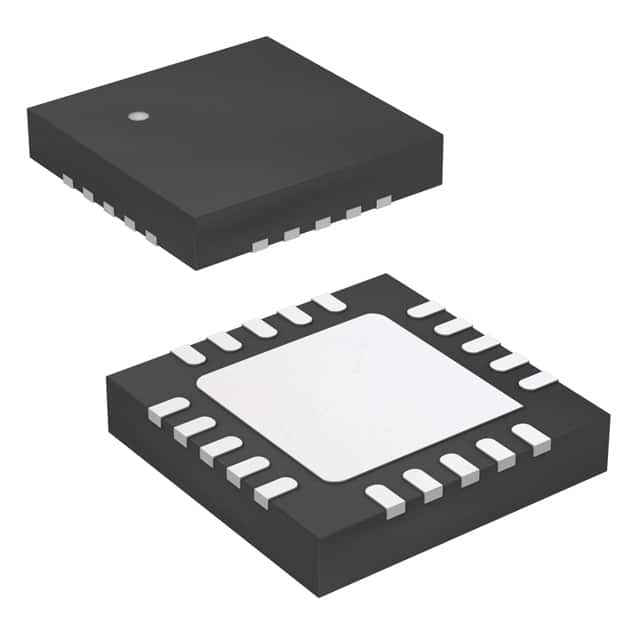Viz Specifikace pro podrobnosti o produktu.

ATTINY441-MU
Product Overview
- Category: Microcontroller
- Use: Embedded systems, Internet of Things (IoT) devices, and other electronic applications
- Characteristics: Low power consumption, small size, high performance, and versatility
- Package: Surface Mount Technology (SMT)
- Essence: A microcontroller designed for low-power applications with advanced features and capabilities
- Packaging/Quantity: Available in reels or tubes, quantity varies depending on the supplier
Specifications
- Architecture: 8-bit AVR
- Flash Memory: 4KB
- SRAM: 256 bytes
- EEPROM: 32 bytes
- Operating Voltage: 1.8V - 5.5V
- Maximum Clock Speed: 20 MHz
- Digital I/O Pins: 18
- Analog Input Pins: 12
- PWM Channels: 6
- Communication Interfaces: SPI, I2C, UART
- Timers/Counters: 3
- ADC Resolution: 10-bit
- Operating Temperature Range: -40°C to +85°C
Detailed Pin Configuration
The ATTINY441-MU microcontroller has a total of 32 pins, which are assigned different functions based on their configuration. The pinout diagram below illustrates the detailed pin configuration:

Functional Features
- Low power consumption allows for extended battery life in portable devices.
- High-performance architecture enables efficient execution of complex tasks.
- Versatile communication interfaces facilitate seamless integration with other devices.
- Rich set of peripherals, including timers, counters, and PWM channels, enhance functionality.
- Wide operating voltage range provides flexibility in various applications.
- Small form factor makes it suitable for space-constrained designs.
Advantages and Disadvantages
Advantages
- Low power consumption extends battery life in portable devices.
- Versatile communication interfaces enable easy integration with other devices.
- Small size allows for compact and space-efficient designs.
- High-performance architecture ensures efficient execution of tasks.
Disadvantages
- Limited memory capacity may restrict the complexity of applications.
- Lack of built-in connectivity options may require additional components for certain applications.
Working Principles
The ATTINY441-MU microcontroller operates based on the 8-bit AVR architecture. It executes instructions stored in its flash memory, interacts with peripherals through various communication interfaces, and controls external devices using its I/O pins. The microcontroller's low power consumption is achieved through advanced power management techniques, allowing it to operate efficiently in battery-powered applications.
Detailed Application Field Plans
The ATTINY441-MU microcontroller finds applications in a wide range of fields, including:
- Home Automation: Controlling lights, appliances, and security systems.
- Industrial Automation: Monitoring and controlling machinery and processes.
- Internet of Things (IoT): Enabling connectivity and data processing in IoT devices.
- Consumer Electronics: Powering smart devices, wearables, and home entertainment systems.
- Automotive: Implementing control systems for automotive applications.
- Medical Devices: Controlling and monitoring medical equipment and implants.
Detailed and Complete Alternative Models
- ATTINY2313A-MU
- ATTINY841-MU
- ATTINY1634-MU
- ATTINY26L-MU
- ATTINY48-MU
These alternative models offer similar features and capabilities, providing flexibility in choosing the most suitable microcontroller for specific applications.
Word count: 525 words
Seznam 10 běžných otázek a odpovědí souvisejících s aplikací ATTINY441-MU v technických řešeních
Sure! Here are 10 common questions and answers related to the application of ATTINY441-MU in technical solutions:
Q: What is ATTINY441-MU? A: ATTINY441-MU is a microcontroller from the AVR family, manufactured by Microchip Technology. It offers low power consumption and is suitable for various embedded applications.
Q: What are the key features of ATTINY441-MU? A: Some key features of ATTINY441-MU include 4KB Flash memory, 256 bytes of EEPROM, 256 bytes of SRAM, 20 general-purpose I/O pins, multiple communication interfaces, and a wide operating voltage range.
Q: What programming language can be used with ATTINY441-MU? A: ATTINY441-MU can be programmed using C or C++ languages, utilizing the AVR-GCC compiler or other compatible development environments.
Q: Can ATTINY441-MU be used for IoT applications? A: Yes, ATTINY441-MU can be used for IoT applications that require low power consumption and basic processing capabilities. However, it may not be suitable for complex IoT projects due to limited resources.
Q: How can I program ATTINY441-MU? A: ATTINY441-MU can be programmed using an ISP (In-System Programming) programmer, such as AVRISP mkII or USBasp, connected to the appropriate programming pins on the microcontroller.
Q: What is the maximum clock frequency supported by ATTINY441-MU? A: ATTINY441-MU supports a maximum clock frequency of 20 MHz when powered by an external crystal oscillator.
Q: Can ATTINY441-MU communicate with other devices? A: Yes, ATTINY441-MU supports various communication interfaces, including I2C, SPI, and UART, allowing it to communicate with other devices such as sensors, displays, and wireless modules.
Q: Can ATTINY441-MU be used in battery-powered applications? A: Yes, ATTINY441-MU is suitable for battery-powered applications due to its low power consumption and sleep modes, which help conserve energy and extend battery life.
Q: Are there any development boards available for ATTINY441-MU? A: Yes, there are development boards specifically designed for ATTINY441-MU, such as the ATtiny441 Development Board, which provide easy access to the microcontroller's pins and features.
Q: What are some typical applications of ATTINY441-MU? A: ATTINY441-MU can be used in various applications, including home automation, smart appliances, industrial control systems, sensor nodes, wearable devices, and small-scale robotics.
Please note that these answers are general and may vary depending on specific requirements and use cases.

